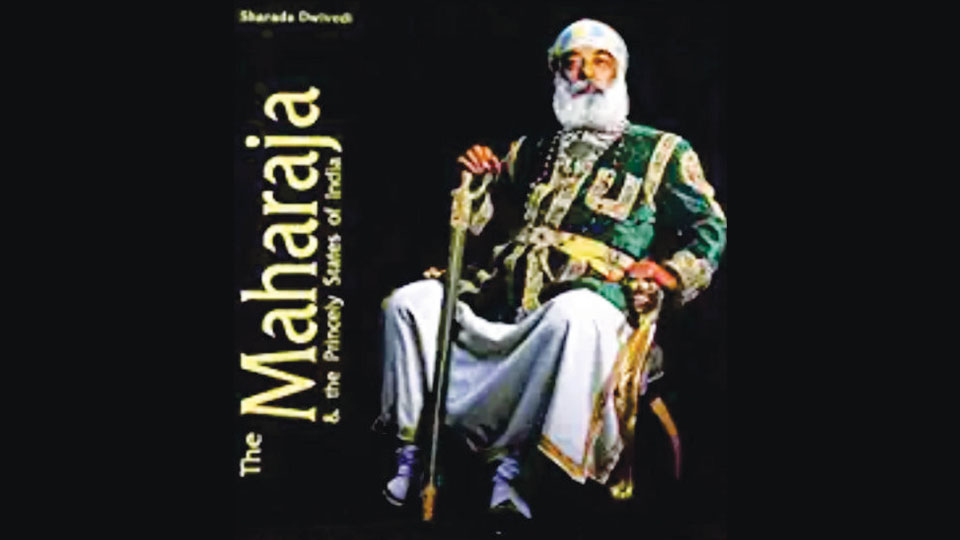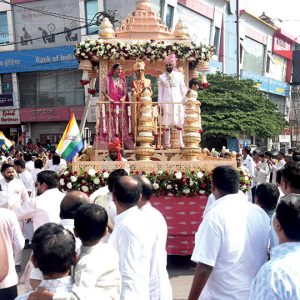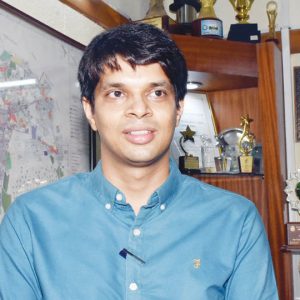By Gouri Satya, Sr. Journalist
- Title: ‘The Maharaja & the Princely States of India’
- Author: Sharada Dwivedi
- Year: 2002
- Pages: 156
- Price: 224 dollars
- Publisher: The Vendome Press, New Toekm USA
Whenever I come to the US, I make it a point to visit the Sunnyvale Library in San Francisco. A beautifully designed coffee-table book drew my attention at the history aisle when I visited the Library this time. It was titled ‘The Maharaja & the Princely States of India.’
Richly illustrated with colour plates, it is authored by Sharada Dwivedi. It was published in the US twenty years ago when Srikanta Datta Narasimharaja Wadiyar was the head of the Mysore Wadiyar family. He also figures in this book among the twenty Maharajas. However, the description is limited to his ancestry, dishes made at festivals, his wedding and the Lalitha Mahal Palace, all in a few lines. The other rulers covered are Jodhpur, Jaipur, Bharatpur, Kotah, Kishengarh, Karauli, Bikaner, Jaisalmer, Udaipur (Mewar), Patiala, Baroda, Gwalior, Jammu and Kashmir, and a few others in brief.
Sharada Dwivedi was a well-known historian, researcher and author. She lived in Mumbai and died on Feb. 6, 2012.
The blurb on the flap says that this book ‘shows the hidden world of princely India in all its glory with photographs of former rulers and their living descendants, many of whom are as revered today as they were in the past, despite the modest lifestyle they have been obliged to adopt. Tourists can become princes for a night or two by staying in one of the several expensive hotels that have been made out of former Palaces. The book will delight all those interested in the history of the subcontinent, its pageantry, jewellery and traditions.’ This sums up the content and objective of the book.
In defence of the Princes
The foreword is written by Arvind Singh Mewar of the Udaipur Palace. It is naturally in defence of the Princes who lost their princely status and kingdom overnight. He laments that history has done injustice to them and has failed to give importance to their sacrifice and their voluntary and willing absorption of their States into the Union of India, though it was ‘one of the most astonishing transitions in world history.’ Similarly, it has also failed to highlight or even acknowledge the significant and major role of many of the former rulers in the struggle for India’s independence. ‘Such is the weakness of democracy,’ he laments.
He praises the Maharajas for adapting to change in an orderly manner, instilling in their people a feeling of pride that democracy was not something princely families would fight against, but something they would welcome for the good of their people and for the continued unification of their great country for which they had over centuries laid down their lives to maintain a unified country against foreign occupation.
Arvind Singh also refers to the ‘selfless sacrifice’ made by the Princes when the special status guaranteed under the Indian States in 1947 to them was revoked by amending the relevant Article. He describes it as ‘yet another betrayal by the government in power in 1971.’ The Princes, however, declined to translate into protest or into dangerous resistance. ‘These significant facts have been largely underplayed and deliberately suppressed,’ he says.
The Maharajas
There were over 560 rulers in the undivided India at that time and were called variously. They varied in size and wealth. Some States had budgets comprising millions of rupees while others had merely a few hundred. The Residents or Agents appointed by the British government kept an eagle eye on the goings on within each State. The States were divided into three main categories — 118 Salute States, 117 Non-Salute States, while the third included 327 hereditary landowners, known as jagirdars, thakurs and talukdars. Of the 118 States, only five rulers were accorded gun salutes ranging from 21 down to 19, 17, `15, `13, 11 and nine. They included Mysore, besides Hyderabad, Baroda, Gwalior and Jammu & Kashmir.
The rulers maintained close contact with the people and spent several hours listening to their complaints and allegations. They toured their territories with no bodyguards, barricades, pilot cars or outriders. There were no security arrangements ‘as are evident with the politicians in the India of today.’ Of course, there were exceptions. While some Maharajas squandered away the entire assets and revenues of their States, others left the entire administration to their Dewan and their Council of Ministers. However, there were several model States ruled by enlightened rulers like Mysore, Baroda, Travancore, Hyderabad, Indore, Gwalior, Bikaner and even smaller States like Aundh, Sawantwadi and Gondal.
Indian rulers had amassed enviable collections of jewellery. The most celebrated bejewelled artifact ever produced in India was the Peacock Throne, pillaged from Delhi by Nadir Shah of Persia. The most famed jewel in the world, the Kohinoor diamond, adorns the British Queen. There were innumerable other marvels, including the Pitt, Orlov and Hope diamonds, which left Indian shores to dazzle the Western world. The most collection in recent times was that of the ‘slovenly, eccentric, but brilliant’ Osman Ali Pasha, the last Nizam of Hyderabad. He owned the famous 162-carat uncut Jacob Diamond, mounted on a gold base and used as a paperweight. He also had a set of ten flawless square emeralds, each the size of a small egg. His wealth in gold alone was once calculated at about thirty million pounds and jewels of the same value. He had mountains of gold and silver in an underground cellar. They were mostly amassed through gifts he received as a Nazar at his durbars. When the Government of India asked for a loan, gold sovereigns and silver bars were brought from Hyderabad to Bombay by a special train in which the royal treasure filled two railway wagons!
Amongst other rulers who owned magnificent jewellery were the Maharajas of Jaipur, Gwalior, Kashmir, Baroda, Indore, Patiala and Jodhpur. Significantly, Mysore does not figure among them.
Some Maharajas had their eccentricities and led a lavish life. The Nawab of Junagadh, for example, adorned his pet dogs. He kept his canines in the lap of luxury and celebrated their birthdays and weddings in grand style! The late Nawab Hamid Ali Khan of Rampur was said to have had over three hundred cooks in his employ, each specialising in preparing a particular type of dish.
The independence of India in 1947 saw the beginning of the end of their princely life. Some Maharajas, however, wisely provided for alternate means of sustenance like setting up private trusts for their employees and institutions they had established, converting their Palaces into hotels, contesting elections and becoming politicians or joining diplomatic services. Their enchanted world has, however, ended altogether and relegated to the pages of history.
Yet it should be noted that their contribution to posterity has vastly enriched the culture and development of the country. It is in evidence in the shape of dams and canals, educational institutions and libraries, art galleries and museums, architecture, wildlife sanctuaries and zoological parks; in classical music and dance and in exotic cuisine; on the playing field, in splendid Palaces and Palace hotels where the discerning visitor can still savour the graciousness of times past.








The major library in the UDSA is the Library of Congress. In Britain, the British Library has the collection on all information on India, so much that even Sir C P Ramaswamy Iyer, used to visit this British Library frequently for the material for his books. The last time he visited this Library was in 1966, when he passed away in London. I do not think any other library is as good as the British Library in areas concerning India.
We should recognise, the Maharajas had no real power. Whatever the power they wielded were given to them by the British Viceroy of the day. Saying anything else is talking nonsense.
Yesterdays Maharajas were replaced by today’s Political Maharajas. It is the same, only them enjoy the fruits of the labor. If ordinary people question anything, they will be prosecuted. Earlier it was sepoys, now it is police.
What is the purpose of this article, except that Mr Gauri Satya wants the readers of the SOM to know that he visits the USA and in particular San Francisco ? Every one visits the USA these days. Lots of Indian IT techies swelter in the Bay area busily doing program coding 24/7!
It will be a very good experience to share with the SOM readers, if this journalist had visited the Library of Congress in Washington DC, and wrote about it.
As for the material contained in this book related to so called Maharajas of yore behind the glitz and exaggerated glory lied the excesses of these individuals, of which there were many., which were well known at the time of independence when Sirdar Patel ‘s staff disclosed them.
Srikanta Datta Narasimharaja Wadiyar was not even a Maharaja when the book was published. His father Jayachamaraja Wadiyar, lost his title of Maharaja when Sirdar Patel removed their exalted positions and rendered them as ordinary citizens.
“Some Maharajas had their eccentricities and led a lavish life. The Nawab of Junagadh, for example, adorned his pet dogs. He kept his canines in the lap of luxury and celebrated their birthdays and weddings in grand style! The late Nawab Hamid Ali Khan of Rampur was said to have had over three hundred cooks in his employ, each specialising in preparing a particular type of dish”
The above were mild excesses, as compared to what Jayachamaraja Wadiyar ( JC Wadiyar) with his ADC Mahadevaiah were up to in 1950s. The presence of a German woman in the latter years in 1960s for example in JC Wadiyar’s Bangalore Palace. . Interesting also to explore the colourful life of Srikanta Datta Narasimharaja Wadiyar in Mysore during late 1960s, particularly in relation to the buxom women folks of a hotel owner household in the VV market, whose hotel was noted for its masala dosa dish for years.
Srikanta Datta Narasimharaja Wadiyar and his father Jayachamaraja Wadiyar spent more time at Bangalore Palace, more than they did at the Mysore Palace in their later years, and died there. Rumours were- they were suffering from diseases that they wanted Mysoreans not to be aware of, to put it politely!
Time to move on. Harping on Wadiyars and other maharajas of yore is no longer interesting to the younger generation of Mysoreans, as the world has changed significantly in this 21st century.
Hello Gouri Satya
This pice you have written sounds as much inane and nonsensical, as your previous article in regards to the heritage structures, where you ranted about the neglect of structures, where you included Yele Thota. It is not true , as you can see this SOM news piece in this issue titled: “Crocodile Caught At Yele Thota. In your above nonsensical piece you did not even put a caveat sating ‘part of Yele Thota’, but gave the impression to readers that the Yele Thota- a long chain covering most of Ramanuja Road, was obliterated- an indirect accusation, which is turned out be not true.
My suggestion to you , is to let go your inflated self belief that you are an expert inall things of heritage Mysore, about Wadiyars and Maharajas , and move on. One would have thought that you would have realised this after your ‘Samachar’ paper folded up.
I do not share the unalloyed praise and enthusiasm Gouri Satya displays in regards to Wadiyars. He often gives the impression that Wadiyars were rulers with independent powers. That was untrue. Wadiyars worked under the direction and order of the British Viceroy of the day, who was their boss. Without British Viceroy’s permission, Wadiyars would not be able to move even a straw, let alone exercise their own power . This fact does not come out lucidly when Gouri Satya writes admiring the Wadiyars, .
A few weeks ago, in releasing a book by Gouri Satya, the SOM owner Mr Ganapathy said, Wadiyar dynasty lasted longer than those of Chola and Hoysala dynasties. But, as always Mr Ganathy has been economical in truth. Chola and Hoysala rule predated to the British occupation of India. Hence, they were really independent rulers exercising their own powers.
The British rescued Wadiyar dynasty by defeating Tipu Sultan. The British there after allowed the Wadiyars to function, under their directions.
Hence, whatever developments that took place under the Wadiyars, such as the Shivasamudram hydroelectric project and Bangalore electric street lighting under Sir K Sheshahdri Iyer, the then Dewan or KR Sagar dam construction and Mysore state development under Sir MV had the blessings of the British Viceroy of the day who had to approve them.
The credit that I would give to Wadiyars like Nalwadi , was his ability to identify the right Dewan, who could do the work well. The rest the Dewan like Sir MV did under approval from the British Viceroy who ruled through his representative, the British Resident in Bangalore.
It is time , Gouri Satya, acknowledged the above clearly, and gave due credit to the British Viceroys who allowed the Wadiyars to function well through their Dewans.
The landmarks like The Dufferin Clock Tower and the Lansdowne Building, were constructed by the Wadiyars in gratitude to the British Viceroys – Lord (Marquess) Dufferin and Lord (Marquess) Lansdowne who visited Mysore from Delhi to support the Wadiyar of the day, and allowed the Wadiyar concerned to function, as faithful subordinates. That simple.